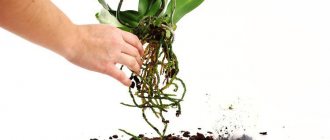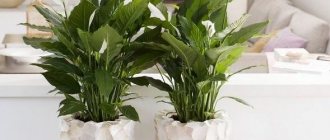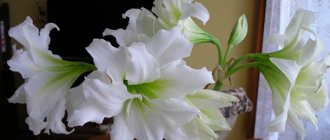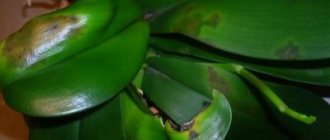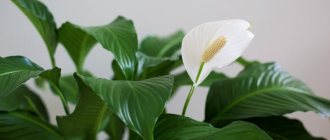What kind of pot is needed for an orchid?
Before deciding which pot to plant an orchid in, you should understand that the main task is to bring the conditions for growing a flower in an apartment as close as possible to natural conditions. The container performs a supporting function; it supports and guides the growth of the flower. The roots of the plant stick to the substrate and the walls of the pot, just like trees in nature. In addition, the container and substrate protect the plant roots from drying out.
Blooming orchids
Basic requirements for containers
When choosing dishes for keeping an orchid, each gardener chooses his own approach. Some prefer to grow the plant on blocks or in a closed system, while others choose a pot.
When choosing a suitable vessel for an orchid, you should pay attention to the following criteria:
- The container must contain a sufficient number of drainage holes so that the roots of the epiphytes can breathe freely.
- The transparent material of the pot is more important for ease of care, as it allows you to control the dosage of watering, monitor the condition of the roots and the phase of development of the plant.
- Orchid loves containers that fit the size of the root system. If the roots of the plant are healthy, then when replanting, take a larger container with room for growth. Sick flowers with damaged roots need a back-to-back pot, since a large amount of substrate will lead to stagnation of moisture and rotting of the roots.
- Which pot to choose depends on the type of plant. Phalaenopsis prefer transparent containers; for vande, it is better to choose glass; for epiphytes with pseudobulbs, ordinary ceramic containers are suitable.
Advice! To create additional aeration of the roots, you can make holes in the bottom and sides of plastic pots using a hot rod, soldering iron or drill.
Variety of orchid pots
Humidity and temperature in and around the pot
Epiphytes cannot tolerate waterlogging of the root system. Therefore, when choosing a container for a flower, you need to make sure that there are drainage holes on the bottom and bottom of the container. If there are no such holes, you should carefully monitor the humidity of the substrate. Stagnation of moisture can lead to mold on the roots of the orchid and its death.
In the absence of air circulation at the root system, the upper shell of the roots begins to rot and the plant does not receive the required amount of moisture and microelements.
Advice! If air circulation is insufficient, then a small fan can be installed near the flower.
The correct temperature is maintained thanks to the material from which the pot is made. It should not contribute to overheating or hypothermia of the root system.
Some orchid containers are equipped with an automatic watering system, which allows you to control the humidity of the plant substrate. This self-watering system is suitable when you cannot devote a lot of time to the plant, for example during vacation or a business trip.
How to choose a container for planting an orchid
It is best to place the plant in a transparent container. A glass vessel serves as a good support for the flower. In such a container it is easier to discern the causes of the disease and identify parasites.
You should choose the right pot size. It needs to be a little tight. The roots of the plant to the very bottom should fit snugly against its walls so that the soil does not become waterlogged.
It is better to choose a container that is narrowed at the bottom and widened at the top. Then the air flow will be sufficient for the roots.
There are also disadvantages to glass containers. There are no drainage holes. Due to excess moisture, plants may rot. Therefore, you must strictly observe the dosage during watering.
Transparent plastic pots
Most orchids go on sale in plastic transparent pots for transportation. This container has several advantages:
- This is a budget option and it is easy for the seller to monitor the watering of the plant through the transparent walls;
- the roots of epiphytes practically do not stick to the plastic and, if desired, it can be easily removed for propagation or replanting;
- The root system of most orchids synthesizes light in the same way as the leaf of the plant, so transparent containers will ensure access of light rays to the roots.
Soil for dracaena - which one is needed and how to choose
The advantage of plastic containers is that you can make additional holes in them along the walls or bottom of the container yourself. This is perfect for a flower. The disadvantage of such a vessel is that it is very light and unstable. To avoid the plant tipping over, it is enough to choose a stable pot for orchids.
Advice! A plastic pot with a drainage system on the bottom and sides is the ideal way to grow phalaenopsis.
In addition to ordinary white plastic pots, in a flower shop you can choose a plastic flowerpot that will suit the interior of your home or office, of any size or color; it can be either transparent or matte.
Orchid in a transparent plastic pot
Clay and ceramic pots
Substrate for orchids - which one is best for growing?
Compared to plastic containers, these types are more stable and aesthetically pleasing. The porous structure of the material provides the necessary moisture and air exchange to the root system, but at the same time it is the reason for the development of flower diseases. Over time, the roots stick to the surface of the pot and, if you want to replant the plant, they are injured, which leads to damage to the orchid. Also, during watering, moisture evaporates through the pores and leaves salts on the walls, which are harmful to the health of the plant.
For reference! In a flower shop you can find two types of ceramic containers intended for epiphytes. They can be glazed or unglazed.
To safely care for the plant, it is better to choose earthenware with a glazed inner surface, then the roots will not be able to grow to the surface.
When choosing glazed dishes that look attractive, do not forget about the presence of a drainage system, without which the plant will not survive for long. An important point when choosing a ceramic flowerpot is the shade of the container itself. The best option would be light-colored dishes - this will help protect the plant from overheating its roots in the summer at elevated air temperatures.
Ceramic pots for orchids
Flowerpots made of ceramics or clay are more suitable for terrestrial varieties of orchids. Having bought just such a pot, the plant will feel as close as possible to its natural habitat.
Important points when choosing a pot
Epiphytes and lithophytes are plants that should not have their roots over-watered. This point should definitely be taken into account when buying a pot. But there are still some requirements that cannot be ignored.
Containers for orchids must contribute to:
- Unimpeded outflow of moisture;
- Natural oxygen saturation of the root system and substrate in the flower container;
- Safely remove rhizomes that periodically extend beyond the container;
- Maintaining a favorable temperature.
Taking this into account, it turns out that:
- There should be holes for drainage at the bottom of the container and at the walls next to it;
- The height of the pot and the diameter of the neck should be the same;
- The volume of the container must correspond to the parameters of the roots.
As you can see, not only the aspect of how to properly care for an orchid in a pot is important, but also what the pot itself is.
Glass pots
In glass flowerpots, orchids look quite aesthetically pleasing. Such containers are quite practical in terms of benefits for the plant’s root system, as they provide a good amount of light to the roots.
How to replant Kalanchoe - what soil and pot are needed
But among flower growers, opinions on the use of this particular material for growing plants are divided. On the one hand, this method helps to retain moisture in conditions of low environmental humidity, but on the other hand, a closed container without drainage is a bad option for the plant.
Due to the accumulation of condensation on the walls of the flowerpot, green algae develops on the roots of the orchid. Replacing the substrate 2-3 times a year will help get rid of this problem.
Attention! Only experienced gardeners who can control the humidity level of the substrate can care for orchids in glass flowerpots.
For beginners and amateurs, it is better to select glass vessels that have at least one hole for air and moisture circulation.
Plant care
An equally important factor in preserving an orchid in a glass pot is special care. To do this you need:
- Water the plant correctly. Using a funnel, water the flower only on top of the soil. Then turn the pot over, holding the roots, and drain the remaining water.
- In a glass pot, the soil retains moisture longer, so watering occurs less frequently than in a regular pot with holes, approximately once every 14 days. Because of the transparent walls of the container, it is easier to monitor the condition of the soil.
- The top layer, which dries faster, can be sprayed with a spray bottle.
- When the plant begins to grow, you need to fertilize it using mineral fertilizers, adding them to the water for irrigation. In a glass container, this should not be done as often as in a standard one with holes.
- The plant is replanted every two years, since moisture is retained in such a pot longer.
A glass pot retains moisture for a long time because there are no holes. You can drill holes at the bottom of the pot, although this will not be entirely aesthetically pleasing. But the plant will be much better.
It is difficult to preserve such a delicate plant as an orchid in a glass vessel, but it is possible. If you want to grow and preserve such an exquisite and unique flower, you need to carefully follow the rules of care and watering. Then everything will work out. A glass accessory will match its beauty and delicacy.
Found a violation? Report content
Hanging planter
It is quite difficult to create conditions reminiscent of natural ones for a plant at home. This can be done using decorative vessels - flower pots. An ordinary pot with a plant is placed in such containers; most often, they do not have additional holes for water drainage, so you can hang the pot on the wall and not worry that water will drip onto the interior items during watering.
There is a wide variety of types of pots:
- plastic, can be with or without holes, transparent or matte;
- glass;
- ceramic;
- baskets made of wood, plastic or metal.
All of them are suspended using ropes, fishing lines, cables or mounted on supports or stands.
Attention! A hanging transparent flowerpot for orchids is more suitable for small-sized plants, since you will have to remove it from the flowerpot during maintenance.
Most often, mini and midi varieties of orchids are placed in flowerpots, but some lovers of indoor plants are ready to keep large specimens in this way.
General concepts
How is a flowerpot different from a regular pot?
- There are several interesting interpretations of the word itself. Origin French. Cache-pot" - "hidden pot" or "hide the pot":
- Decorative vessel without holes in the bottom. A pot with a plant is installed inside;
- Decorative shell. Optional for pots;
- Vase to disguise a flower pot. "Cover for a flower pot." Redkin's Russian Dictionary;
- The difference between a flowerpot and a simple pot is obvious. The pot is placed in a flowerpot. But not a flowerpot in a pot.
What is it for?
It is quite difficult for each plant to provide conditions reminiscent of the climate from its place of origin in an apartment. So, what should be a pot for orchids:
- There is no need to create waterlogging for them. It's even harmful;
- Moisture should leave easily , without problems;
- The substrate and container should provide good aeration;
- It is necessary to extract the root system from them without much difficulty. And the roots are original. They are long and powerful in many species;
- Maintain a certain temperature regime;
- Provide light access to the roots. In some species, roots participate in photosynthesis. Give them transparent pots and flowerpots;
- That is why flowerpots, pots, vases, blocks and baskets are so carefully selected .
Unusual pots for orchids
Recently, flower growers are increasingly choosing the Corona plastic pot for orchids for their green spaces. It is a through structure made of flexible transparent plastic rods. The rods, arranged in a circle, have small gaps to hold the soil. Included with such containers is a special double tray, which can be used to create drainage; the presence of special fasteners allows you to hang the plant in a pot.
Crown pot for orchids
This type of container has a large number of advantages, including providing light for photosynthesis, good ventilation, and the original style of the product.
Despite the advantages, there are some disadvantages of such a pot. Through the large holes in the container, the substrate can be poured into the tray and then the roots will grow through the pot. For the same reason, moisture evaporates much faster and it becomes necessary to create additional conditions for water retention. During transplantation, problems may arise associated with damage to the root system of the flower, since the roots can grow through the walls of the Crown.
For reference! An orchid crown with a tray is suitable for plants whose roots are active in photosynthesis.
DIY orchid pot
To add originality to the vessels in which orchids are grown, inventive gardeners are ready to make flowerpots with their own hands. These can be wicker baskets, plaster flowerpots of fancy shapes. Some people prefer to plant the plant in a regular large coconut. There are a lot of options for creating a homemade pot - it all depends on the imagination of the creator.
Homemade orchid pot
Such home-made structures have one significant drawback - a rough surface to which roots can grow, which will cause problems when the plant needs to be replanted.
Growing an orchid at home is an art, as a result of which the gardener receives a spectacular flower. Choosing the right pot is an important point in caring for the plant, which will ensure health and full development.
